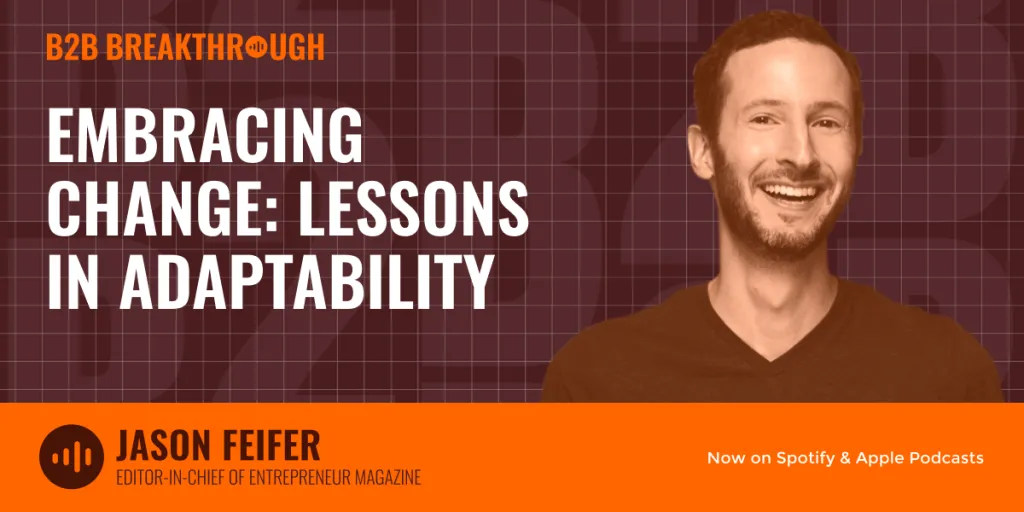In an increasingly volatile market, adaptability isn’t just an advantage—it’s a necessity. But what does it take to embrace change? Turns out, much can be learned from those at the forefront of entrepreneurship and innovation. In this episode of the B2B Breakthrough Podcast, we sit down with Jason Feifer to get an insider’s look at how entrepreneurs are redefining business by leveraging the inevitability of change.
Table of Contents
Who is Jason Feifer?
Vertical thinking: A key to entrepreneurial success
The core of adaptability: Transferable value
The dual nature of fear
Differentiating minor shifts from major transitions
Who is Jason Feifer?
Jason Feifer is the Editor-in-Chief of Entrepreneur Magazine, and an influential figure in the world of business and e-commerce. He has excelled in various facets of the media industry, having worked at multiple magazines before climbing the ladder to his current position. Aside from his editorial expertise, Jason is also renowned for his roles as a podcast host, book author, keynote speaker, and startup advisor. His commitment to guiding others toward resilience and adaptability in a rapidly changing business landscape has made him a cherished mentor for many aspiring entrepreneurs.
Vertical thinking: A key to entrepreneurial success
At the heart of what sets entrepreneurs apart is their inherent inclination towards vertical thinking. In stark contrast to horizontal thinkers, who tend to complete tasks and promptly move on, entrepreneurs embrace a markedly different approach. They possess a unique vision, perceiving each action not as an isolated event but as a crucial component of a larger, more complex puzzle. This entrepreneurial mindset revolves around seeing every step, every decision, and every challenge as integral to a grander scheme. It’s about understanding that today’s efforts are not just about immediate results but are instrumental in paving the way for future success.
“Entrepreneurs are vertical thinkers. It’s not a natural way of thinking. Entrepreneurs think that the only reason to do something is because it is the foundation upon which the next thing will be built, you don’t have to know exactly where you’re going… You don’t have to know the ROI on why you do something, but you better make sure that every effort is used so that you feel like you’re building towards something.”
Vertical thinking is crucial in a dynamic business world, where adaptability and foresight are key. It enables entrepreneurs to not just survive but thrive amidst continuous change. This approach is far more than a strategy; it’s a mindset embedded in the very DNA of entrepreneurial success.
The core of adaptability: Transferable value
Jason believes that the core of adaptability lies in identifying and nurturing your essential transferable value—the unique skills or attributes that define you—irrespective of changing circumstances. This is especially vital in times of change, as it allows for adaptability and success across different scenarios.
“People who are really good at being adaptable are really good at recognizing what I call ‘the thing that does not change in times of change.’ where they are able to identify the thing about them, the value that they create.”
He emphasizes shifting from a job-specific identity to a broader, more enduring skill set. By understanding and leveraging these core attributes, individuals and businesses can thrive in changing environments. This adaptability, rooted in a firm understanding of one’s intrinsic value, paves the way for continuous growth and innovation, regardless of external changes.
The dual nature of fear
Fear, as Jason points out, plays a dual role in the entrepreneurial journey. He categorizes fear into two types: the fear of losing what one has, and the fear of not finding the next opportunity swiftly enough. The latter, rooted in a belief in abundance, acts as a powerful driving force, propelling individuals towards new ideas and opportunities. Jason encourages embracing this fear, as it fosters a proactive mindset, crucial for exploration and risk-taking.
“Once you recognize that these two fears exist, you can start to calibrate yourself towards them. It’s important to say fear is OK. Fear is OK. Change is really scary. There’s nothing that I can or should be able to say that would eliminate that fear. But the thing is that just because it’s scary, doesn’t mean that it’s bad. Or just because it’s scary, doesn’t mean that there’s not something that you can do with it.”
This perspective transforms fear from a paralyzing obstacle to a catalyst for growth and exploration. He stresses the importance of recognizing and accepting fear as an integral part of the journey toward change and innovation.
Differentiating minor shifts from major transitions
Jason introduces an exercise for entrepreneurs to follow in the face of change – differentiating between ‘doors’ and ‘engines’. He explains this with a compelling analogy:
“Let’s just say that you’re driving down the street in Brooklyn, New York, and the door falls off your car. Can you still get where you’re going? Yeah, you should fix that. It’s not very safe, but you can still get going. Now, let’s say you’re driving down the street in Brooklyn, New York, and your engine falls off the car. Can you get where you’re going? The answer is no.”
‘Doors’ symbolize minor changes that might require attention but don’t fundamentally alter your trajectory. ‘Engines’, in contrast, are major shifts that can redefine your direction entirely. This distinction is crucial for assessing and identifying the appropriate response to change, ensuring that your focus, energy, and resources are directed towards what truly matters.
Interested in more of this conversation? Check out the full podcast episode via the links below. Be sure to subscribe, rate, review, and share!
Click the Apple Podcast link
Click the Spotify link




